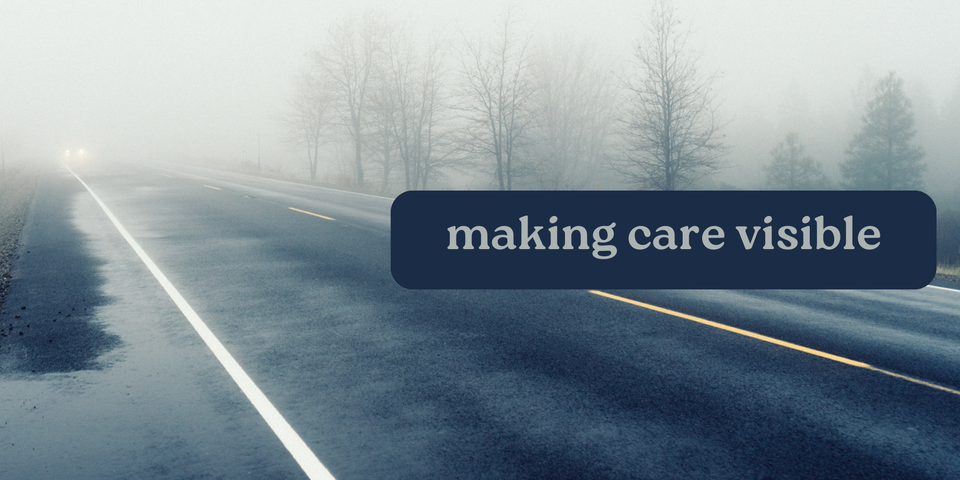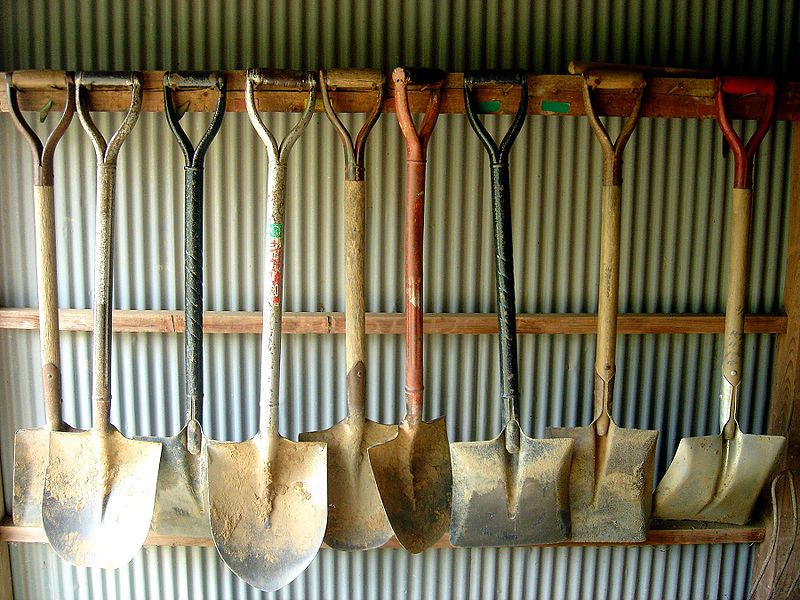Making care visible

I’ve been thinking a lot about care lately. About the invisible ways that the work of care, both paid and unpaid, ties us all together, and how this is the foundation on which everything else rests.
I’ve also been thinking a lot about how hard care can be, the obligations, the complications and the pressures, alongside the violence and abuse.
This care can be paid and unpaid, formal and informal, delivered by people we know and those we don’t. It can be given with love and hate, at times from the same people and systems.
This work of care is invisible, instead of seen as fundamental to the entire rest of the community, the economy if you like. Nothing would exist without this work, but that invisibility means that profound questions of how that work happens are pushed to the margins.
Everyone needs and uses care throughout their lives. From the time we are babies, to when, if we are lucky to, we grow old, our very existence relies on our communities willingness to wipe our arses, feed us and keep us from harm. For those of us who need more care between infancy and old age, the questions about that work of care are something we have thought long and deep about.
This often comes as a surprise in policy discussions about care, about support, about making that work visible, about counting that labour. I sit in rooms having these discussions, and always, always, have to interject that disabled people have thoughts and expertise about this care, theories, policies, decades and decades of thinking about different aspects of that care, and how it is provided.
This knowledge was behind the push for the NDIS, is behind much of the current work and debates about the future of the Scheme, but also is missing from the in-vogue discussions of the care and support economy. How do the threads of discussions about care and support weave together into something better and more durable?
Like many other disabled people, those who were meant to care for me didn’t, instead punishing me for being disabled and turning away in actual disgust from the manifestations of my impairments. The scars this has left have changed how I live my life and how I understand being a disabled person in this world.
I was left with the strong belief that not only did I not need care, I didn’t deserve it. I fled that abuse into the arms of yet more abuse and it was a very long time before I was able to unpick that damage.
The first people to really engage with my inability to understand care were nurses. They would paint potions the consistency of wall grout every day on every part of my body, while explaining, incredibly patiently, that it was ok to find this hard and to need help to survive. They figured out that I was continually unwell in part because I had no money; they helped me believe I could go to university, and faxed my application from the nurses station. They found the support I needed, fought to get me help at home and kept me alive.
I didn’t know why they kept persisting with me. It didn’t make any sense, but they refused to let me go. I would have died without them.
This is how I began to understand what care looked like. These people, paid to support me, did their jobs well, within a system that purported to be all about care. Of course, much of the medical system isn’t like this even remotely, but those nurses, at that time, did more than just apply that damn shit on my skin over and over.
Family care, informal care, remained incredibly fraught for me.
Until fairly recently, those expectations of care from family, were something I strongly fought against. I didn’t understand the families in the disability movement because I didn’t understand that care they provided. I didn’t believe it was real or genuine or could ever not be harmful.
I am grateful, always, to folks who have had the very long conversations over the last few years with me, to help me understand that yes, sometimes family can do what they are meant to do.
But I’m not sure that they really understand the reasons that so many of us feel so strongly about not relying on family for care. Or really believe that families can be as awful as too many of us understand them to be.
And as much as I found my chosen family, care remained difficult. I said, over and over, as a much younger person, that I didn’t want my friends to be my carers. For me, care was dangerous, damaging, painful no matter who was doing it, even when that was not the case. I preferred strangers, paid to do that job, over those who felt any kind of obligation towards me.
Ideas of care are complex for disabled people. The intimacy of that care is something those policy makers who write about the care and support economy do not reckon with. The idea that those of us that need and use care might have some very bloody strong opinions about that work is entirely absent.
When disabled people started to fight for control of their support, they used language deliberately to separate that paid support from unpaid or informal care, often provided by family members. At the time, the alternative to family support was an institution, big and small, with no control or choice in sight.
This push, for care to become support, for unpaid to move to paid, is vital to understand both the NDIS and much of the argument against it by some conservative economists, politicians and bureaucrats.
The recent death of John Walsh has led to some good reflections about the role he played in building the economic arguments for this change that included moving to individualised funding. At the same time, the Attendant Care Coalition and others were building the policy case.
This work and expertise of disabled people has become invisible, even though these groups are still here, with echoes still visible of these fights for recognising the need for care to become support, and for disabled people to have a say about that care.
While the disabled peoples’ movement was working through the 1990s and beyond to push for care work to both be recognised as skilled and essential labour, and to move it beyond informal care and families, the feminist movement was doing something similar, but for different reasons.
Professor Marilyn Waring, an academic from Aotearoa and Member of Parliament, wrote some of the seminal works on the economic value of unpaid care work, and why counting that care was vital in economic measures like the Gross Domestic Product, or GDP.
Waring talked about how vital it was to actually start counting this care work, to make it visible in how we account for our national figures. She said that:
“When we look at the amount of time that's taken in the unpaid sector, what we find is that in almost every country where I've ever seen the data, it is the single largest sector of the nation's economy.”
Not mining, IT, health care or anything else that gets the headlines, but unpaid care work.
Feminist economists and academics have long argued that this unpaid care work becomes recognised. Anne Manne, who has written a great deal about exactly this, said in 2018 that:
“While taxpayers debated whether we could “afford” the $6 billion price tag of the NDIS, we were making invisible this care work provided to people with a disability by predominantly female caregivers. This care was valued by Deloitte Access Economics at $43.7 billion in their report The Economic Value of Informal Care in Australia 2015, while the replacement value of the whole unpaid care sector was more than $60 billion.”
[Unrelated, how quaint does it look to see a $6b total cost for the NDIS.]
These two threads converged around the NDIS in a way that is important to understand, now that the whole Scheme is both under threat and facing significant change. Attitudes towards this care work are important in terms of what is valued, and what we, disabled people, want that care to look like.
But within this feminist work, there is little understanding or acceptance of disabled people as anything other than the subjects of care. We aren’t carers ourselves, let along experts in what makes decent care and support.
Within mainstream economic discussions, care and support, whether paid or unpaid, remains marginalised and barely visible. In part, this is about how we value those of us being cared for.
At the end of 2022, I made a submission (#111) to the Senate Inquiry on Work and Care where I said that:
“All of this work, while opening up economic discussions to include care, builds on old ideas about the economic worth of disabled people, that idea that there is a neat divide between disabled and non-disabled, between sick and well. We are too often seen as outside the economy, as burdens, as having little value, and this has a very long history.”
The unpaid and paid care and support we give and receive is seen as invisible, or somehow a drain, rather than an enabler. As are disabled people.
The essential nature of care and support to all parts of being human comes in stark contrast to conventional economics, and leads to pieces like this from the Australian Financial Review, talking about the NDIS as an ‘economy killer’.
Full of hilarious anecdotes, hearsay and deep contradictions, this article can’t conceive of care and support work as having much value, or being a part of the ‘real’ economy. The piece says the NDIS ‘has become a monster, and appears to be slowly killing the economy.’
It matters little about the jobs created, the economic valuing of previously uncounted unpaid care work, or the essential nature of this work to commentators like this. This work isn’t real work, and certainly isn’t something they should have to think about.
There is much more to write about care work, so I can feel another series coming on. I want to go back to Georgia Van Toorn’s book about the convergence of neoliberalism and the push by disabled people for individualised funding.
I also want to examine how in an effort for this care work to be recognised as part of the ‘economy’, neoliberal commodification of that care has come to be the predominant model of how that is delivered and understood. Care is packaged up to be bought and sold on the stock market, making profiteers billions, while delivering poor quality and rationed services.
Those who use care and support are supposed to be the consumers, and yet are far more likely to become the commodities, traded among those who are actually the players in the market.
Can we even imagine a public model of care and support that delivers control and choice for disabled people? Can we afford not to? That is what the next posts will be about over the next little while.
Postscript
I’ve not written about the NDIS legislation on purpose because my heart aches from some of the conversations I’ve had and been part of, and I’m not sure what is left to say any more. Anyway, we’re going back to the Community Affairs Committee for another round of arguing about anything other than what is actually in the damn legislation or the amendments. Let’s see if I can set a new record of a fourth appearance at the same inquiry about the same issue.
